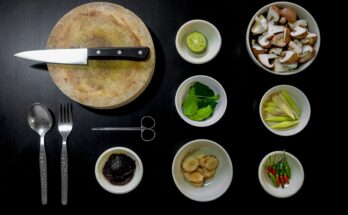Cooking is a universal art form that transcends borders, cultures, and time. Whether you’re a seasoned chef or a novice in the kitchen, the importance of selecting the right products for cooking cannot be overstated. The ingredients and tools you use play a pivotal role in determining the taste, texture, and overall success of your culinary creations. In this comprehensive guide, we will delve into the intricate process of choosing the right products for cooking, encompassing ingredients, utensils, and cookware. By the end of this article, you’ll have the knowledge and confidence to make informed choices that elevate your cooking to new heights.
-
Ingredients Matter
 (Photo from iStock)
(Photo from iStock)
The foundation of any great dish begins with the quality and selection of ingredients. Whether you’re preparing a simple pasta dish or a gourmet feast, understanding how to choose the right ingredients is essential.
Freshness is Key
One of the cardinal rules of cooking is to prioritize freshness. Fresh ingredients not only taste better but also provide superior nutritional value.
- Fruits and Vegetables: Look for vibrant colors, firm textures, and a lack of blemishes or bruises. Avoid produce that appears wilted or has an off-putting odour.
- Meat and Seafood: When selecting meat, opt for cuts that are bright red (for beef) or pink (for poultry and pork) with minimal marbling. For seafood, choose fish with clear, glossy eyes and a fresh oceanic scent.
- Herbs and Spices: Fresh herbs should be fragrant and vibrant in color. Spices should be stored in airtight containers away from light and moisture to maintain their potency.
Organic vs. Conventional
The choice between organic and conventional ingredients is a matter of personal preference and budget. Organic products are grown without synthetic pesticides or fertilizers, making them a popular choice for those seeking to minimize exposure to chemicals. Conventional products, on the other hand, tend to be more budget-friendly. Keep in mind that while organic options may be healthier for you and the environment, both can be used in cooking effectively.
Seasonal and Local Ingredients
Cooking with seasonal and locally-sourced ingredients is a fantastic way to support local farmers and ensure you’re getting the freshest produce. Seasonal ingredients are also more likely to be at their peak flavour, which can elevate your dishes.
-
Choosing the Right Utensils
 (Photo from iStock)
(Photo from iStock)
In the kitchen, the right utensils can make the difference between a seamless cooking experience and a frustrating one. From knives to cutting boards and measuring tools, here’s how to choose the right utensils for your culinary adventures.
Knives
A good set of knives is the backbone of any kitchen. Here’s what to consider when selecting knives:
- Knife Types: Invest in a chef’s knife, a paring knife, and a serrated knife as essential basics. Specialty knives like boning knives and bread knives can be added as needed.
- Material: High-quality stainless steel is a preferred choice due to its durability and resistance to corrosion.
- Comfort and Grip: Choose knives with comfortable, ergonomic handles that allow for extended use without fatigue.
- Maintenance: Knives should be easy to sharpen and maintain. Consider whether they require frequent honing or professional sharpening.
Measuring Tools
Accurate measurements are crucial in cooking. Invest in quality measuring cups and spoons, a kitchen scale, and a liquid measuring cup for precise ingredient quantities.
Cookware
Pots and pans come in a variety of materials, each with its own advantages and disadvantages:
- Stainless Steel: Stainless steel cookware is durable, non-reactive, and resistant to staining. It’s ideal for browning, deglazing, and creating fond.
- Cast Iron: Cast iron cookware retains heat exceptionally well and provides excellent heat distribution. Seasoning is necessary to prevent rust and maintain non-stick properties.
- Non-stick: Non-stick cookware is great for low-fat cooking and easy clean-up. However, it may not be as durable as other options and can deteriorate over time.
- Copper: Copper cookware offers precise temperature control but can be expensive and requires regular polishing to maintain its appearance.
- Aluminium: Aluminium cookware is lightweight and heats up quickly, but it may react with acidic ingredients, leading to off-flavours.
- Ceramic: Ceramic cookware is non-reactive and provides even heat distribution. It’s a good choice for baking and braising.
Consider your cooking style, budget, and maintenance preferences when selecting cookware.
-
The Role of Seasonings and Condiments
 (Photo from iStock)
(Photo from iStock)
Seasonings and condiments are the flavour enhancers that elevate your dishes from ordinary to extraordinary.
Salt
Salt is an essential seasoning in cooking, but not all salts are created equal:
- Table Salt: This fine-grained salt is the most common. It’s perfect for general cooking and seasoning during or after cooking.
- Kosher Salt: Kosher salt has larger, flakier crystals, making it easier to control when seasoning by hand. It’s a favorite among chefs for its texture and versatility.
- Sea Salt: Sea salt comes in various forms and colors, each with a unique flavour profile.
- Himalayan Pink Salt: Known for its pink hue, this salt is mined from ancient sea salt deposits in the Himalayas. It has a mild, slightly earthy flavour.
Herbs and Spices
Herbs and spices add depth and complexity to your dishes. When choosing herbs and spices:
- Dried vs. Fresh: Dried herbs are more concentrated in flavour than fresh, so you’ll need less. However, fresh herbs provide a vibrant, aromatic quality that dried ones can’t match.
- Storage: Store dried herbs and spices in a cool, dark place away from moisture. Keep an eye on expiration dates to ensure freshness.
- Experiment: Don’t be afraid to experiment with different herbs and spices to create unique flavour profiles.
Sauces and Condiments
Sauces and condiments can transform a simple dish into a culinary masterpiece:
- Read Labels: Pay attention to the ingredients in store-bought sauces and condiments. Look for products with natural ingredients and minimal additives.
- Homemade vs. Store-Bought: Consider making your sauces and condiments from scratch for more control over flavour and ingredients.
Dietary Considerations
When choosing ingredients and products for cooking, it’s important to take dietary considerations into account. Whether you’re cooking for yourself, family, or guests, being mindful of dietary restrictions and preferences is crucial.
Reference:
mealime
Want some amazing jewellery making ideas, that too at your home, what are you waiting for?, click on the link below:
Homemade Jewellery making for kids




